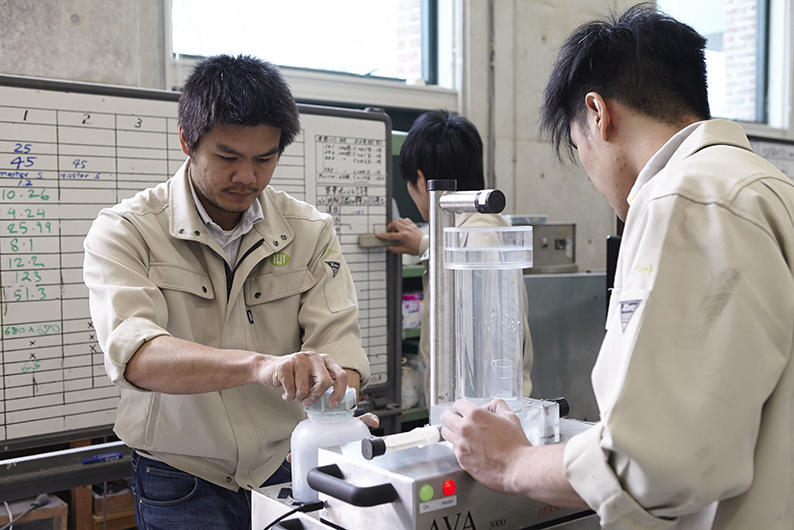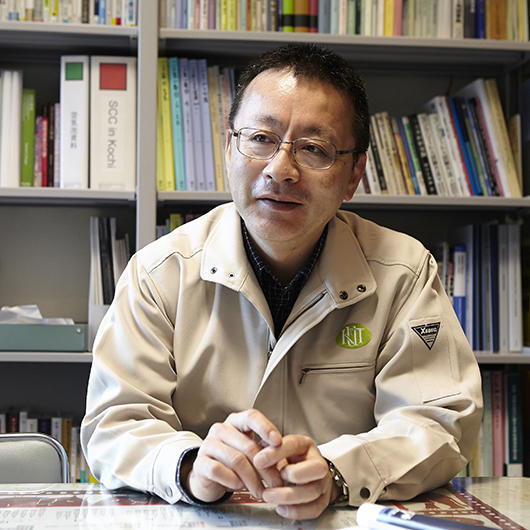- TOP
- Cutting-edge Research and Social Contribution
- Cutting-edge Research
- New concrete technology: Towards a safe and environment-friendly society

New concrete technology: Towards a safe and environment-friendly society

Self-compacting concrete: Overturning conventional conceptions
Concrete, the most widely used construction material in Japan, is essential for infrastructure improvements such as roads, bridges, levees and dams. Its quality affects not only the reliability of social infrastructure, but also the safety and affluence of people's lives. Professor Ouchi, a concrete expert, has been conducting materials research towards further improvement of the reliability of construction. His research theme over the 30 years since he was a student is 'self-compacting concrete' (SCC).
Concrete exhibits its designed performance when it is compacted firmly in a formwork lined with reinforcing bars. However, compacting work requires highly compliant technique: if the compacting is insufficient, both strength and durability may be impaired. Self-compacting concrete (SCC), developed as a solution to compacting problems, flows by its own weight into every corner of a formwork lined with reinforcing bars, eliminating the need for compaction by vibration. SCC is an epoch-making material that demonstrates optimum performance regardless of the construction technique. In the early 1980s, when early deterioration of concrete was emerging as a social problem, SCC was proposed by Prof. Ouchi's former teacher, KUT ex-president Prof. Hajime Okamura, who at that time was on faculty at the University of Tokyo. SCC was realized in 1988. This world-first original technology created in Japan has now been studied in various countries and has found application in many structures and buildings.
Prof. Ouchi first encountered SCC when he joined Prof. Okamura 's concrete laboratory. After completing his doctorate, Prof. Ouchi joined KUT when it was established in 1997. Since then, he has assumed the responsibility for widely disseminating Prof. Okamura's creation, SCC, and has been engaged in developing its technology.
Prof. Ouchi says, "Even if one creates good things, disseminating them is another story. I have been pursuing ways of balancing quality and price. Although it is certainly true that 'even if it's expensive, a good thing is good,' if we do not consider the users' viewpoint and develop a technology in the optimum direction, society won't see the value and won't adopt it."
Prof. Ouchi said SSC is often used in bridges and buildings that require extremely high strength, but it has rarely found use in ordinary structures.
A possible path to dissemination: air bubble miniaturization
Although self-compacting concrete has been highly evaluated as a "revolutionary high-performance material," its dissemination has proven extremely difficult. The major factor hindering broader application has been the cost. To strike a balance between fluidity and viscosity, self-compacting concrete should have a smaller amount of sand and gravel and a larger amount of cement than conventional concrete. As a result it costs about twice as much as conventional concrete. As the amount of cement increases, the strength increases accordingly, but the demand for high-strength concrete is limited to special structures, which is only about 5% of total constructions. A long-standing agenda has been the development of new self-compacting concrete capable of fluidity but requiring less cement while maintaining the strength of conventional concrete. Four years ago, Professor Ouchi came up with a solution to the problem.
He explains, "When we reduce the amount of cement, the friction caused by gravel and sand increases and fluidity is impaired, so I wondered whether it could be possible to increase the fine air content rather than that of cement, and reduce the friction by creating a kind of cushion."
Although no results emerged for two years, eventually the attempt to use miniature air bubbles gave good results, and Prof. Ouchi succeeded in reducing the friction between materials using air. Eventually he achieved an economical "bubble lubrication type self-compacting concrete" with strength at the same level as conventional concrete but at much lower cost. In the end, the price, which had doubled with the new technology, was reduced to only about 20% more than that of conventional concrete.
Since SCC made it possible to securely fill concrete, even in complicated forms, without using special materials or vibration or compaction, construction time was shortened and design freedom was greatly improved. In addition, this concrete turned out to be useful thanks to its strength under earthquake conditions.
Prof. Ouchi continues, "In order for concrete to endure the lateral vibration of an earthquake, it is necessary place reinforcing bars both vertically and horizontally. Usually it is difficult to flow concrete into spaces where the reinforcing bars are dense, but this concrete overcomes such problems easily."
Currently multiple prototypes have been produced at a ready-mixed concrete factory in order to secure stable supply, with the aim of practical application within one year's time. Popularization, Prof. Ouchi's long-time wish, has been emerging as a reality.
Prof. Ouchi's theme for technology development is "a paradigm shift from high performance to high reliability."
Prof. Ouchi says, "Since civil engineering structures and buildings require secure spaces that last for a long period of time, I think there is no point in pursuing high performance and strength beyond what is necessary for each component. Although of course a minimum strength is necessary, it would be more effective for the improvement of the economy if we used a large number of materials that achieve high reliability at lower price than if we reduced dimensions and thickness for high performance. That is a major premise of civil engineering, from the point of view that technology should be useful in the field. "
Degradable Sustainable Concrete (DSC) utilizing the power of nature
While concrete is a simple and inexpensive construction material, it has the disadvantage that it does not revert to nature. Therefore, concrete has been seen as contributing to environmental destruction; it interrupts the cycle of material circulation. For that reason Prof. Okuchi started a new research project in 2015 to put concrete in a material circulation cycle using natural energy.
The idea of the research came to him when he was asked by a biomass power plant in Sukumo City about ways of using the ash that remains after wood is burned. Prof. Ouchi thought that he could use a large amount of wood ash as a material for concrete. In addition, he thought that he would prefer if possible to avoid using cement, since ash is a natural substance. So, aiming at making concrete that can be degraded to soil when its role as a structural component is finished, he has been working to develop a method for solidifying concrete without using cement. He found that that could be accomplished simply by adding water and lime to wood ash.
"Wood ash returns to the soil eventually; it is even used as a fertilizer. Also, lime is spread on farm soil as a soil conditioner: it does not have a harmful effect on the environment. If we use cement, the intensity of concrete will increase immediately. However, I did not dare use cement and pursued only materials that would eventually return to the soil. Fortunately, my prototype materials hardened."
Subsequently in 2016 Prof. Ouchi completed a prototype of degradable sustainable concrete. If this can be realized practically, it will surely attract a lot of attention as environmentally friendly next-generation concrete.
Prof. Ouchi continues, "Ash contains a high concentration of chlorine and there is a danger of oxidation of the reinforcing bars if the concrete is poured into a formwork which contains reinforcing bars, so we are considering using this concrete in the form of independent blocks. Its strength is about 10 percent of conventional concrete but it is sufficiently strong that it will not break even if a car it runs over it. We are currently pursuing research towards even greater strength."
If bubble-type self-compacting concrete can be supplied stably, it will lead to enhanced earthquake resistance and a safer society in Japan, well-known as an earthquake-prone country. It will also lead to environment-friendly technology by reducing the amount of cement used. Moreover, if degradable sustainable concrete is realized, a new value will be achieved: the process of making concrete will be part of a direct solution to environmental problems, and the potential of concrete will be greatly increased.
Prof. Ouchi concludes, "Since civil engineering is in essence the placing of things on the earth, it is important to understand nature, fear it and make the most of it." He and his team are continuing to develop technologies that will overturn current concrete common sense and will last in a reasonable state for a long time.
